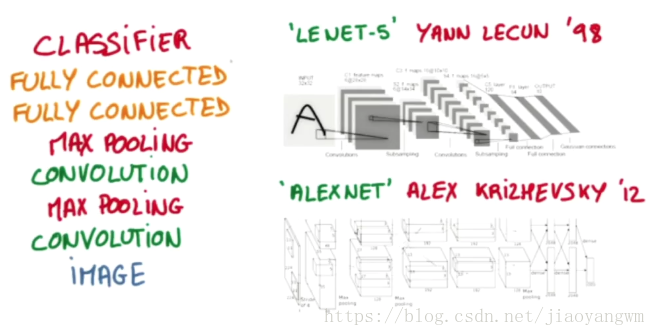第三节,CNN案例-mnist手写数字识别
卷积:神经网络不再是对每个像素做处理,而是对一小块区域的处理,这种做法加强了图像信息的连续性,使得神经网络看到的是一个图像,而非一个点,同时也加深了神经网络对图像的理解,卷积神经网络有一个批量过滤器,通过重复的收集图像的信息,每次收集的信息都是小块像素区域的信息,将信息整理,先得到边缘信息,再用边缘信息总结从更高层的信息结构,得到部分轮廓信息,最后得到完整的图像信息特征,最后将特征输入全连接层进行分类,得到分类结果。
卷积:
经过卷积以后,变为高度更高,长和宽更小的图像,进行多次卷积,就会获得深层特征。
1)256*256的输入(RGB为图像深度)
2)不断的利用卷积提取特征,压缩长和宽,增大深度,也就是深层信息越多。
3)分类
池化:
提高鲁棒性。

搭建简单的卷积神经网络进行mnist手写数字识别
网络模型:
输入[sample*28*28*1](灰度图)
[ 28 * 28 *1 ] --> (32个卷积核,每个大小5*5*1,sample方式卷积) --> [ 28 * 28 * 32] --> (池化 2*2 ,步长2)--> [14 *14 *32]
输出:10个分类
1、定义变量weight_variable、bias_variable
start = np.random.randint(1, 100)
end = start + 10
test_res=sess.run(prediction,feed_dict={xs : mnist.test.images[start:end],keep_prob: 0.5} )
sess.close()
第三节,CNN案例-mnist手写数字识别的更多相关文章
- [Python]基于CNN的MNIST手写数字识别
目录 一.背景介绍 1.1 卷积神经网络 1.2 深度学习框架 1.3 MNIST 数据集 二.方法和原理 2.1 部署网络模型 (1)权重初始化 (2)卷积和池化 (3)搭建卷积层1 (4)搭建卷积 ...
- Android+TensorFlow+CNN+MNIST 手写数字识别实现
Android+TensorFlow+CNN+MNIST 手写数字识别实现 SkySeraph 2018 Email:skyseraph00#163.com 更多精彩请直接访问SkySeraph个人站 ...
- Tensorflow实现MNIST手写数字识别
之前我们讲了神经网络的起源.单层神经网络.多层神经网络的搭建过程.搭建时要注意到的具体问题.以及解决这些问题的具体方法.本文将通过一个经典的案例:MNIST手写数字识别,以代码的形式来为大家梳理一遍神 ...
- mnist手写数字识别——深度学习入门项目(tensorflow+keras+Sequential模型)
前言 今天记录一下深度学习的另外一个入门项目——<mnist数据集手写数字识别>,这是一个入门必备的学习案例,主要使用了tensorflow下的keras网络结构的Sequential模型 ...
- 深度学习之 mnist 手写数字识别
深度学习之 mnist 手写数字识别 开始学习深度学习,先来一个手写数字的程序 import numpy as np import os import codecs import torch from ...
- 基于tensorflow的MNIST手写数字识别(二)--入门篇
http://www.jianshu.com/p/4195577585e6 基于tensorflow的MNIST手写字识别(一)--白话卷积神经网络模型 基于tensorflow的MNIST手写数字识 ...
- mnist 手写数字识别
mnist 手写数字识别三大步骤 1.定义分类模型2.训练模型3.评价模型 import tensorflow as tfimport input_datamnist = input_data.rea ...
- 持久化的基于L2正则化和平均滑动模型的MNIST手写数字识别模型
持久化的基于L2正则化和平均滑动模型的MNIST手写数字识别模型 觉得有用的话,欢迎一起讨论相互学习~Follow Me 参考文献Tensorflow实战Google深度学习框架 实验平台: Tens ...
- 用MXnet实战深度学习之一:安装GPU版mxnet并跑一个MNIST手写数字识别
用MXnet实战深度学习之一:安装GPU版mxnet并跑一个MNIST手写数字识别 http://phunter.farbox.com/post/mxnet-tutorial1 用MXnet实战深度学 ...
随机推荐
- tar压缩解压文件
查看visualization1.5.tar.gz 压缩包里面的内容: $ tar -tf visualization1.5.tar.gz 解压指定文件JavascriptVisualRelease/ ...
- (count 或直接枚举) 统计字符 hdu1860
统计字符(很水) 链接:http://acm.hdu.edu.cn/showproblem.php?pid=1860 Time Limit: 1000/1000 MS (Java/Others) ...
- 分析JVM GC Dump 工具
GC 日志分析工具: http://gceasy.io/ JVM Dump 文件分析工具: IBM HeapAnalyzer
- java io系列07之 FileInputStream和FileOutputStream
本章介绍FileInputStream 和 FileOutputStream 转载请注明出处:http://www.cnblogs.com/skywang12345/p/io_07.html File ...
- Sidetiq 定时任务
class SidekiqCreateMonthPlanWorker #定时自动生成下月计划 include Sidekiq::Worker include Sidetiq::Schedulable ...
- Ubuntu 开启SSH服务以及有关设置:安装,指定端口号、免密登录、远程拷贝
本文所用系统为 Ubuntu 18.04 什么是SSH? 简单说,SSH是一种网络协议,用于计算机之间的加密登录.全名为:安全外壳协议.为Secure Shell的缩写.SSH为建立在应用 ...
- Part-Four
1. 2. 3. 4. 5. 6. 7. 8. 9. 10. 11. 12.
- LeetCode(192. Word Frequency)
192. Word Frequency Write a bash script to calculate the frequency of each word in a text file words ...
- 067、如何部署Calico网络 (2019-04-10 周三)
参考https://www.cnblogs.com/CloudMan6/p/7509975.html Calico 是一个纯三层的虚拟网络方案,Calico为每个容器分配一个IP,每个host都是 ...
- [Android] Android Studio 修改Gradle使用国内源
Gradle 仓库中心的项目,下载速度又比较慢, 网上查询了下, 使用阿里云的Maven镜像仓库 在 project 的 build.gradle中修改如下: allprojects { reposi ...
